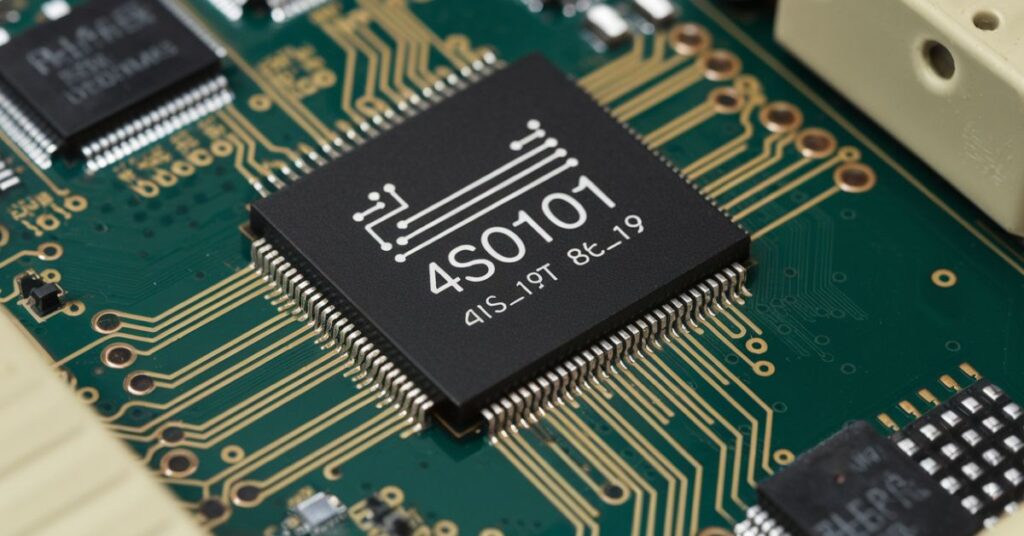One of the most significant advancements in the field of integrated circuits (ICs) is the 4S0101. Chips like the 4S0101 are essential in propelling technological advancement, particularly in light of the growing need for gadgets that are smarter, quicker, and more efficient. These compact and adaptable parts are essential to modern electronics, from cell phones to industrial equipment.
A problem for modern device designers is striking a balance between energy efficiency and performance. Although increasingly powerful components are needed to meet the needs of advanced gadgets, battery life and small form factors are always of utmost importance. These issues are successfully resolved by the 4S0101 chip, which provides excellent performance, low power consumption, and versatility for a variety of uses.
Technical Specifications
The 4S0101 chip is notable for both its technical mastery and broad functioning. Here are some precise details:
Chip Architecture & Design: The sophisticated microarchitecture of the 4S0101 processor is tuned for speed and efficiency. It can perform complicated operations quickly because it incorporates many transistors into a tiny die. High throughput and low latency are made possible by the design’s support for both parallel and serial processing.
Power Consumption & Performance: The 4S0101 chip’s low power consumption is one of its primary characteristics. It lowers the energy demand on devices and was designed with energy efficiency in mind, which is especially advantageous for battery-powered applications. Power savings don’t come at the expense of performance; it can tackle demanding computing operations without overheating or rapidly draining the battery.
Size & Form Factor: This chip can fit into small locations in electronic equipment because it was developed to be as small as possible. Because of its small form factor, it may be included into a wide range of products without increasing their total size.
Communication Protocols Supported: I2C, SPI, UART, and other communication protocols are supported by the chip. Because of this, it may be used in a variety of systems and integrates easily with sensors, controllers, and other peripheral devices.
Key Features
The 4S0101 chip has a number of important features that improve its functionality and usability:
High Processing Power: Fast data processing on the 4S0101 chip enables it to do intricate calculations rapidly. Because of this characteristic, it is an excellent option for systems that require quick computations, including industrial automation real-time data processing or automobile control systems.
Low Power Consumption: Battery-operated gadgets, such as wearables or Internet of Things devices, can function longer on a single charge because of the chip’s ability to tackle demanding tasks without using up too much power. Both the chip and the gadgets it powers have a longer lifespan because of this low-power design.
Compact Design: The 4S0101 chip is ideal for use in consumer electronics, industrial equipment, and medical devices where space is at a premium because of its tiny physical footprint, which makes it simple to integrate into a range of electronic systems.
Versatility in Applications: The architecture of the chip enables its use in a variety of industries, including industrial automation, consumer electronics, automotive, and healthcare. Because of its adaptability, it is the perfect option for manufacturers seeking a dependable and flexible IC.
Applications of the 4S0101 Chip
The 4S0101 chip’s distinctive blend of speed, small size, and power efficiency makes it suitable for a variety of applications.
Consumer Electronics
The 4S0101 chip is a key component of high-end consumer electronics, including game consoles, tablets, smartphones, and smartwatches. It is essential for processing data for functions including controlling touch interfaces, managing user inputs, supplying power to communication networks (such as Bluetooth and Wi-Fi), and facilitating quick data transfers. The chip is essential to the smooth operation, extended battery life, and user experience of devices such as smartphones.
Automotive Industry
One of the main industries where the 4S0101 chip really excels is the automobile sector. The chip, which is found in car control units, aids in controlling vital operations like engine performance, airbag deployment, advanced braking systems (ABS), and other real-time applications. The 4S0101’s processing power and energy efficiency are advantageous for entertainment systems, navigation, and even electric vehicle (EV) control systems in contemporary automobiles. This chip enhances the user experience, efficiency, and safety of vehicles.
Industrial Automation
The 4S0101 chip is incorporated into robotics, sensor management, and equipment control systems in industrial automation. Because of its processing power, production processes may be quickly and precisely controlled, which can greatly increase operational efficiency. It is crucial for managing packing systems, conveyor belts, and robotic arms in automated industries, increasing output and decreasing downtime.
Medical Devices
The 4S0101 chip is ideal for medical technologies since it is precise and dependable. Wearable health monitoring systems, portable medical gadgets, and diagnostic equipment are all powered by it. The 4S0101 chip helps guarantee correct and dependable operation of medical devices due to its low power consumption and real-time processing of complicated data. Wearable health technology helps consumers keep on top of their health by ensuring real-time monitoring of key statistics like blood pressure, heart rate, and oxygen levels.
Advantages of the 4S0101 Chip
The 4S0101 chip offers a number of significant advantages that draw in manufacturers:
Energy Efficiency: It is perfect for portable electronics like wearables, cell phones, and remote sensors because of its low power consumption, which allows products to run for longer on a single charge.
High-Speed Processing: The 4S0101 chip is well-suited for demanding jobs since it processes data fast and efficiently, whether controlling various device components or conducting complex data analysis.
Small Form Factor: Its small size makes it possible to integrate it into devices with limited space without sacrificing functionality.
Wide Compatibility: Numerous communication protocols are supported by the chip, guaranteeing smooth integration into a range of device ecosystems.
Challenges and Limitations
The 4S0101 chip does have many difficulties and restrictions in spite of its amazing feature set:
Compatibility with Older Systems: The 4S0101 chip may be difficult to integrate with older systems or components that aren’t made to function with contemporary communication protocols, necessitating extra labor or modification.
Cost: Even if the chip performs exceptionally well, its production process can make it more expensive than less complex, less potent chips. This may have an impact on end-user product prices.
Processing Power Limitations: The chip may not be the best option for really demanding applications like large-scale data crunching or advanced AI processing, which call for specialist hardware, even though it is quite efficient for a variety of activities.
Future Developments
The 4S0101 chip has a bright future ahead of it, particularly as technology advances. Here are some potential developments:
Next-Generation Applications: Chips like the 4S0101 will be crucial in enabling 5G, IoT, and smart city technologies as the world progresses toward these developments, making gadgets smarter and more connected.
Improved Power Management: Future iterations of the technology are probably going to have even greater power-saving features, which could lead to previously unheard-of increases in the battery life of portable electronics.
Increased Processing Capability: The 4S0101 may develop into a more potent version that can manage more demanding jobs without compromising energy efficiency as processing power demands rise.
Conclusion
The 4S0101 chip is a prime example of integrated circuits of the future; it is small, effective, and adaptable enough to satisfy the needs of today’s quickly changing electronics. The chip is a dependable option for many uses, ranging from driving consumer electronics to vital automotive and medical equipment. It is obvious that the 4S0101 will remain a significant participant in the field of contemporary technology given its energy-efficient architecture, fast processing speeds, and adaptability.
FAQs
What is the 4S0101 chip used for?
Consumer electronics, automotive systems, industrial automation, and medical devices are just a few of the many uses for the 4S0101 chip. It enhances these systems’ energy efficiency and processing speed.
What makes the 4S0101 chip energy-efficient?
For battery-powered devices that must operate for longer periods of time between charges, the chip’s low power consumption and strong performance make it perfect.
Can the 4S0101 chip be used in smartphones?
Indeed, the 4S0101 chip is frequently found in consumer electronics like cellphones, where it performs duties like connection, power management, and data processing.
How does the 4S0101 chip contribute to automotive safety?
To improve vehicle safety, the 4S0101 chip is utilized in vehicle control units in the automobile industry to regulate vital systems including airbags, braking, and engine efficiency.
Is the 4S0101 chip suitable for industrial automation?
In order to maximize production efficiency and guarantee exact operations, the chip is incorporated in machinery and control systems, making it ideal for industrial automation.



